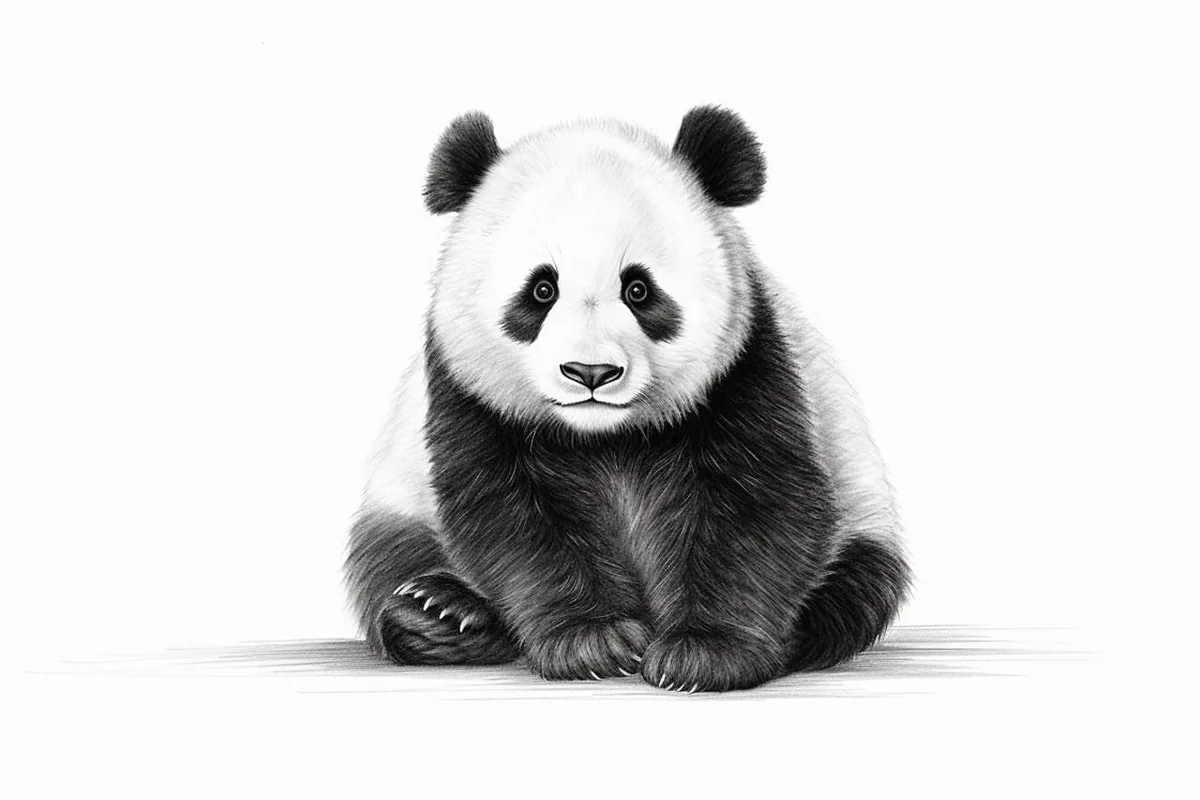How to Draw a Panda in 10 Easy Steps
Learn how to draw with this step-by-step tutorial.

Materials You'll Need
- Drawing paper
- Pencil (HB or 2B)
- Eraser
- Colored pencils
- Markers
- Blending stump

Pandas are some of the most beloved animals in the world, known for their playful nature, fluffy black-and-white fur, and irresistible charm. Whether you're a seasoned artist or picking up a pencil for the first time, learning how to draw a panda can be a fun and rewarding project that captures the essence of this gentle giant.
In this easy-to-follow tutorial, we'll break down the process into simple, manageable steps. By the end, you'll have a beautiful panda drawing that you can proudly display or gift to someone special. So, gather your art supplies—pencil, eraser, paper, and maybe some colored pencils or markers—and let's dive into the wonderful world of pandas. Get ready to bring this adorable creature to life on paper!
Materials Required
To create your panda drawing, you will need the following materials:
Make sure you have these materials ready before we begin.



How to Draw a Panda Step-by-Step
Step 1: Outline the Head
Let's start by drawing the head of our panda. Begin with a simple circle in the center of your paper. This will serve as a guideline for the shape of the head. Don't worry about making it perfect; we can always make adjustments later.
Step 2: Add the Ears
Next, let's add the panda's ears. Draw two small circles on either side of the head, just above the top edge of the circle. These circles should be slightly tilted towards each other. The ears should be relatively small compared to the size of the head.
Step 3: Draw the Eyes
Now, let's give our panda some cute eyes. Draw two small circles within the head, towards the upper part. Leave some space between the circles to add the nose later. Inside each circle, draw a smaller circle or oval to represent the iris. Shade the area around the irises to give the eyes some depth. Don't forget to leave a small spot unshaded to create a highlight in the eyes.
Step 4: Add the Nose
Moving on, it's time to draw the panda's nose. Just below the space we left between the eyes, draw a small rounded rectangular shape. This will serve as the base for the nose. Then, draw a sideways letter "T" shape on top of the base to complete the nose.
Step 5: Draw the Mouth
Let's give our panda a smiling mouth. Draw a curved line just below the nose, starting from one side and ending on the other. Add a small curve at each end of the line to create a slight smile. Feel free to adjust the shape of the mouth to give your panda a different expression if you'd like.
Step 6: Add the Body
Now, let's move on to the body of our panda. Draw a large rounded shape beneath the head, starting from the bottom of the chin. Make sure the body is wider towards the bottom and narrower towards the top. This will create a chubby appearance, characteristic of pandas.
Step 7: Draw the Legs
To create the panda's legs, draw two curved lines extending down from the bottom of the body. These lines should be slightly angled towards each other. Add small rounded shapes at the end of each line to represent the paws. The front legs will be shorter than the hind legs since the panda is seated.
Step 8: Add the Details
Now that we have the basic structure in place, let's add some details to our drawing. Sketch a small circle at the end of each paw to represent the pads. Next, draw a curved line on each ear to create the inner part. Add some fur-like details around the eyes to make them look more natural. You can also add some curved lines on the body to represent the fur.
Step 9: Refine and Outline
Once you're happy with the overall shape and details, it's time to refine your drawing. Use your pencil to darken the lines you want to keep, and erase any unnecessary guidelines or stray marks. Take your time during this step to make your panda drawing look clean and polished.
Step 10: Ink or Color (Optional)
If you prefer a more finished look, you can use a black marker or pen to outline your drawing. This will make your panda stand out and give it a bold appearance. Alternatively, you can use colored pencils, markers, or paints to add some color to your drawing. Feel free to get creative and add your personal touch!
Final Thoughts on How to Draw a Panda
Congratulations! You have successfully learned how to draw a panda. By following these step-by-step instructions, you can create adorable panda drawings anytime you want. Remember to practice regularly to improve your skills and experiment with different poses and expressions. Happy drawing!
Gallery of Panda Drawings






Fun Facts About Pandas
-
Pandas are best known for their striking black-and-white fur and bamboo-heavy diet, which makes up over 99% of what they eat. They consume bamboo shoots, leaves, and stems—sometimes up to 100 pounds per day!
-
Despite their bear-like appearance, pandas were once thought to be related to raccoons. But modern genetic research confirms they are true bears, part of the Ursidae family.
-
Baby pandas are born pink, hairless, and about the size of a stick of butter, making their transformation into fluffy, playful cubs truly remarkable.
-
Pandas have a special extra "thumb"—an enlarged wrist bone—that functions like a sixth digit, allowing them to grip bamboo stalks with impressive precision.
-
Native to the mountainous bamboo forests of China, pandas are mostly solitary and can spend up to 14 hours a day eating to meet their energy needs.
-
Pandas communicate using chirps, honks, growls, and scent markings, especially during mating season. They rely on scent to mark territory and convey information.
-
Unlike other bears, pandas do not hibernate. Instead, they migrate to lower elevations in the winter to stay warm and find fresh bamboo.
-
Pandas are strong swimmers and surprisingly agile climbers, especially when young. Playful cubs often practice tumbling and scaling trees for fun.
-
The giant panda is a global symbol of wildlife conservation, thanks in part to its iconic status as the logo of the World Wildlife Fund (WWF).
-
Pandas have become beloved cultural icons, frequently appearing in books, cartoons, plush toys, and popular media. From Olympic mascots to children's stories, they continue to capture imaginations around the world.
Tip: To achieve the soft, fluffy texture of a panda's fur, consider using a blend of shading techniques with your pencil. Start with light, circular motions to create a base layer for the body, focusing on the areas where the fur is denser, like around the face and belly. Gradually build up darker tones in the shadows, particularly under the arms and around the eyes, using a blending stump or your fingertip to smooth out the pencil marks for a more realistic look. Don't forget to leave some white space to highlight the fur's natural sheen, especially on the face and ears—this will bring your panda to life! Lastly, if you're using colored pencils or markers, layering soft grays or blacks will enhance the depth without overpowering the characteristic white of the panda. Happy drawing!
Suggestions for Scenes and Settings for Panda Drawings
-
Bamboo Forest: Draw a panda sitting lazily in a peaceful bamboo grove, happily munching away with bamboo shoots scattered around.
-
Mountain Meadow: Illustrate a panda wandering through a misty mountain meadow, with wildflowers, mossy rocks, and distant snow-capped peaks.
-
Playful Panda Cub: Create a scene with a young panda rolling down a hill, surrounded by butterflies or forest animals.
-
Panda Nap Time: Depict a panda curled up on a fallen log or napping in the crook of a tree, with gentle sunlight filtering through the leaves.
-
Snow Day Panda: Show a panda frolicking in a snowy landscape, making snowballs or sliding on its belly, with pine trees in the background.
-
Zen Garden: Draw a panda relaxing in a serene Zen garden, surrounded by raked sand, smooth stones, and a small koi pond.
-
Rainy Forest Stroll: Illustrate a panda wandering through a gentle rain, with raindrops dripping from leaves and a pond reflecting its image.
-
Panda and Lantern Festival: Picture a nighttime scene where a panda gazes up at glowing paper lanterns drifting through the sky during a festival.
-
Panda Picnic: Imagine a group of pandas having a bamboo-filled picnic under a willow tree, sharing snacks and snoozing on blankets.
-
Dreamy Cloudscape: For a fun fantasy twist, draw a panda lounging on a fluffy cloud, with stars and the moon twinkling overhead.